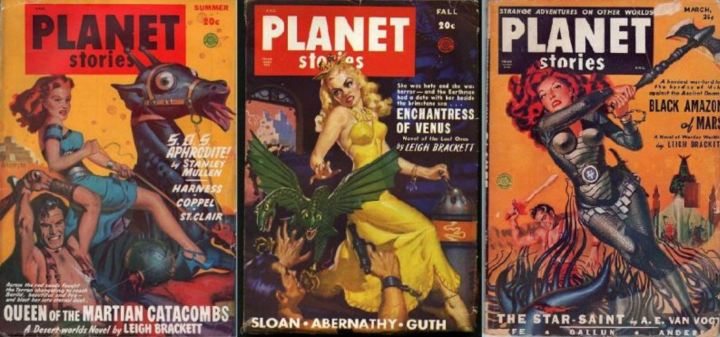
I think we can divide science fiction fans into two eras – before and after July 15, 1965. Before NASA’s Mariner 4 spacecraft flew by Mars there was a certain amount of hope that Mars could have been inhabited, or once inhabited. But those 22 grainy pictures that Mariner 4 sent back shocked us. Mars looked like the Moon, full of craters, a dead world. I was fourteen years old and devastated. I wanted Mars to be like Heinlein and Bradbury imagined.
I’m not sure SF readers today can know what it felt like before Mariner 4. Of course, science fiction was full of Martians, but so was popular culture. The Twilight Zone regularly featured Martians and Venusians. Martians were memes that appeared widely in newspapers, magazines, TV, comics, and movies. There was even a sitcom My Favorite Martian. People back then, even people who didn’t read science fiction, wanted to believe that Mars was an old world, occupied by intelligent beings.

Everyone remembers the menacing Martians of H. G. Wells, and many people remember the exotic Martians of Edgar Rice Burroughs, but I remember the Martians of Robert A. Heinlein. The first Heinlein novel I read was The Red Planet which came out in 1949 but I didn’t discover until 1964. Jim Marlowe its protagonist had a pet Martian he called Willis. It was round with three eyes and could parrot human speech. We eventually learn that Willis is a nymph and would metamorph into what the human settlers called the Old Ones. Heinlein later used these Old Ones in his classic novel Stranger in a Strange Land. They were wise, ancient, and had yogi like psychic powers.
Starting in the 1940s with short stories, later collected into a fix-up novel in 1950, Ray Bradbury gave the world The Martian Chronicles. His Martians were also old, wise, with great mental powers, but they were a dying race. Ray Bradbury’s science fiction never felt realistic, even back in the 1940s. His stories felt more like magical realism, or allegory, yet his Martian chronicles hold up better today than those by Heinlein, Clarke, and Asimov.

Today Mars is a hostile environment for life. Kim Stanley Robinson’s Mars trilogy is the SF standard model for Mars. But I miss Martians. I want Mars to be like Heinlein, Bradbury, and Roger Zelazny imagined.
“A Rose for Ecclesiastes” by Roger Zelazny came out in the November 1963 issue of The Magazine of Fantasy and Science Fiction. I’m pretty sure that Zelazny knew Mars would be like what Mariner 4 would show us, but he also loved the old Martians and wrote this beautiful eulogistic tale about them. I consider it the best story about Old Mars ever written.

Sure, Martians weren’t always nice. Sometimes they were evil, and other times they were annoying pests, like in Fredric Brown’s Martians, Go Home.
But I still miss Martians. I wish that Mariner 4 had sent us back 22 different pictures, ones with ancient cities visible. I’d love to write an alternative history novel about that, but I’d rather it had happened for real. Wikipedia has a long article about Martians in fiction. We can still read those stories, but wouldn’t it had been great if we had discovered Martians in 1965?
This solar system is too lonely, don’t you think? I wish the planets and moons were inhabited like Leigh Brackett and Stanley Weinbaum imagined. The universe is far out. Reality is so much more than we can ever discover, yet sometimes, I wish it was closer to fiction than fact.


James Wallace Harris
i think titan, enceladus, europa are the mars of this generation..
LikeLike
They are locations where we hope to find life, but not Leigh Brackett type life.
LikeLike
I’m four years older. Room in my reading life for both visions of Mars, old and new.
LikeLike
I always thought the Martians in “Double Star” might be the same ones that were in “Red Planet”.
LikeLike
Hi
The Christmas before last I read A Fall of Moondust, Earthlight and The Sands of Mars, all by Clarke and written in the 1950s and early 1960s, even the moon had life, I think it was lichen if I recall correctly. Mars had plants and some kangaroo-like creatures that were not intelligent. Knowing none of this was true I still enjoyed them. I also liked the big cabbage-like plant the kids hid in in The Red Planet. Mars was so rich, at least in the imagination of the science fiction writers, illustrators and movie makers, with classics like Santa Claus Conquers the Martians. It is to bad we have not found signs of life so far, whether it is radio signals or actual organisms but it is nice we have the Mars of Burroughs, Bradbury and Brackett, and that’s just the B’s. Ralph E. Vaughan had a lovely discussion of the same topic over at Book Scribbles.
https://bookscribbles.blogspot.com/2013/06/the-other-solar-system.html
Happy Reading
Guy
LikeLike
Thaanks great post
LikeLike